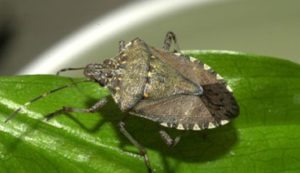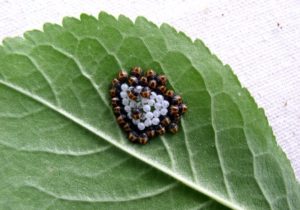Botanical oils offer new options for dealing with brown marmorated stink bug, a new pest to West Coast almond growers. Growers in the East and Midwest have been plagued by the BMSB, as it is also known, for several years, but it is only recently that it has been found in orchards in California.

Adult brown marmorated stink bug
Photo: David R. Lance, USDA APHIS PPQ, Bugwood.org
Adult stink bugs have piercing mouthparts, which they insert into the fruit and suck out plant juices. The resulting damage makes produce unmarketable. In almonds, the damage appears as necrotic brown lesions on the hull and the secretion of a clear gummy substance at the feeding site. This is similar to the damage caused by other types of stink bugs, but is usually more severe with BMSB. These pests are not choosy – peaches, apples, apricots, Asian pears, cherries, corn, grapes, lima beans, nectarines, peppers, tomatoes and soybeans are just a few of the crops BSMB feed on and damage in North America.
The life cycle of BMSB includes five nymphal stages, and all of these feed on both fruit and foliage. One big advantage of botanical oils is they are effective on all of these life stages, plus they can kill the eggs as well, which is unusual for a pesticide.
“Essential oils are very, very good at killing the eggs,” says Steve Bessette, Vice-President of the botanicals division at KeyPlex. “We think it’s because they are excellent solvents — they are oil-based and penetrate right through the egg.”
Prevent Damage by Keeping BSMB Away from Fields
Another characteristic of botanical oils that makes them especially effective against BMSB is their repellent qualities. Keeping pests away from crops in the first place is even better than killing the bugs when they are there — especially with a destructive pest like BMSB.

Newly emerged first-instar BMSB nymphs cluster around an egg mass. Photo: Gary Berndon, USDA APHIS, Bugwood.org
“With BMSB you can kill the insect, but it doesn’t solve the problem of the damaged fruit,” Bessette says. “In particular with stink bug, they tend to feed on the perimeters of the fields — about 50 feet in or so. What we are suggesting is spraying the perimeters with botanicals to keep them out of the fields. Because BMSB have such a broad host range, if you can make an unattractive environment for them, they will go somewhere else.”
Bessette says a field study at Virginia Tech was done on tomatoes that compared Ecotrol, a botanical oil product, with carbamates and synthetic pyrethroids for control of BMSB.
“There was zero damage,” he says. “Botanicals will never be as effective at killing insects as those conventional chemicals — the control and lack of damage we saw was due to repellency in the field where the stink bug chose to go to an untreated crop instead. That has been pretty consistent across species we have looked at. The essential oils are toxic on contact, but even at sub-lethal rates, they are still a repellent and deter oviposition in those crops. Even when the stink bugs do land, they tend to not lay their eggs because they don’t consider it to be a safe place.”
While botanical oils are effective at killing pests on contact, including the BMSB, they have a very short residual period, unlike conventional insecticides. But field studies using botanicals in almond orchards have demonstrated that repellency and the disruption of the life cycle by killing the eggs and/or preventing oviposition combine to create an effective residual length of about three weeks, Bessette says.
Botanical Oils Can Play Key Role in Resistance Management
Because essential oils such as rosemary and mint have different modes of action than those of conventional chemicals like pyrethroids, they can play a big role in resistance management.
“There are nearly 20 separate, pure compounds within rosemary oil,” Bessette says. “Each one of those compounds may have a different target within the insect. We’ve identified octopamine as the primary target for some of these compounds, but we are finding others acting as enzyme inhibitors. It’s next to impossible for an insect to develop resistance to a botanical compound that has 15 or 20 separate compounds inside.”
Safety Means Flexibility
Other features of botanical oils like those in Ecotrol, such as a zero preharvest interval, zero worker reentry period, zero maximum residue level requirements (MRLs), OMRI-listing, EPA Minimum Risk exemption, and FDA GRAS (Generally Recognized As Safe) status, mean growers have complete flexibility with where and when to use botanicals in their spray programs.
For BMSB control in almonds, Bessette suggests taking advantage of the repellent characteristic of botanical oils by spraying the perimeters of fields early in the season when the stinkbugs are searching for a host crop.
“I suggest one or two sprays early and once in the middle of the season as pest pressure naturally begins to build,” Bessette says. “If stink bugs are already present in the field, the entire field should be sprayed. But if it isn’t already established, perimeter sprays can be very effective.”
Bessette says because oils can volatilize more quickly at higher temperatures it’s best to spray in the early morning or late evening. If trees are in bloom, spray in the evening. The short residual means the oil will be gone by morning when bees become active.
